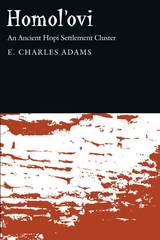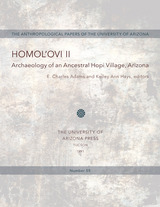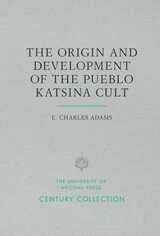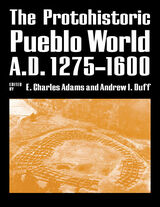4 books about Adams, E. Charles

Homol'ovi
An Ancient Hopi Settlement Cluster
E. Charles Adams
University of Arizona Press, 2002
Beginning sometime in the thirteenth century, people from the Hopi Mesas established a cluster of villages to the south along the Little Colorado River. They were attracted by the river’s resources and the region’s ideal conditions for growing cotton. By the late 1300s, these Homol’ovi villages were the center of a robust trade in cotton among many clusters of villages near or on the southern Colorado Plateau and were involved in the beginning of the katsina religion among Hopi people.
Charles Adams has directed fifteen years of research at these sites for the Arizona State Museum, including excavations in five of the seven primary Homol'ovi villages and in other villages predating them. Through this research he concludes that the founders of these settlements were Hopis who sought to protect their territory from migrating groups elsewhere in the Pueblo world. This book summarizes that research and broadens our understanding of the relationship of Homol'ovi to ancient and modern Hopi people.
Each Homol'ovi village had a unique history of establishment, growth, sociopolitical organization, length of occupation, and abandonment; and although the villages shared much in the way of material culture, their size and configuration were tremendously varied. By comparing Homol'ovi research to information from projects on other settlements in the area, Adams has been able to reconstruct a provocative history of the Homol'ovi cluster that includes relationships among the individual villages and their relationships to nearby clusters. He shows that social organization within villages is apparent by the number and variety of ritual structures, while political organization among villages is indicated by the need for cooperation to share water for irrigation and by the exchange of such materials as pottery, obsidian, and ground stone.
Adams advances several important theories about why Homol'ovi was founded where and when it was, who its founders were, and the importance of cotton in making Homol'ovi an important center of trade in the 1300s. He also considers why Pueblo settlements suddenly became so large, addressing theoretical issues pertaining to multiple settlements and the rise of enormous villages containing more than 1,000 rooms.
Homol'ovi is a rich work of synthesis and interpretation that will be important for anyone with an interest in Southwest archaeology, Arizona history, or Hopi culture. By considering the settlement trajectory of an entire cluster of sites, it will also prove valuable to archaeologists worldwide.
Charles Adams has directed fifteen years of research at these sites for the Arizona State Museum, including excavations in five of the seven primary Homol'ovi villages and in other villages predating them. Through this research he concludes that the founders of these settlements were Hopis who sought to protect their territory from migrating groups elsewhere in the Pueblo world. This book summarizes that research and broadens our understanding of the relationship of Homol'ovi to ancient and modern Hopi people.
Each Homol'ovi village had a unique history of establishment, growth, sociopolitical organization, length of occupation, and abandonment; and although the villages shared much in the way of material culture, their size and configuration were tremendously varied. By comparing Homol'ovi research to information from projects on other settlements in the area, Adams has been able to reconstruct a provocative history of the Homol'ovi cluster that includes relationships among the individual villages and their relationships to nearby clusters. He shows that social organization within villages is apparent by the number and variety of ritual structures, while political organization among villages is indicated by the need for cooperation to share water for irrigation and by the exchange of such materials as pottery, obsidian, and ground stone.
Adams advances several important theories about why Homol'ovi was founded where and when it was, who its founders were, and the importance of cotton in making Homol'ovi an important center of trade in the 1300s. He also considers why Pueblo settlements suddenly became so large, addressing theoretical issues pertaining to multiple settlements and the rise of enormous villages containing more than 1,000 rooms.
Homol'ovi is a rich work of synthesis and interpretation that will be important for anyone with an interest in Southwest archaeology, Arizona history, or Hopi culture. By considering the settlement trajectory of an entire cluster of sites, it will also prove valuable to archaeologists worldwide.
[more]

Homol'ovi II
Archaeology of an Ancestral Hopi Village, Arizona
Edited by E. Charles Adams and Kelley Ann Hays
University of Arizona Press, 1991
Homol'ovi II is a fourteenth-century, ancestral Hopi pueblo with over 700 rooms. Although known by archaeologists since 1896, no systematic excavations were conducted at the pueblo until 1984. This report summarizes the findings of the excavations by the Arizona State Museum of five rooms and an outside activity area, which now form the core of the interpretive program for Homolovi Ruins State Park. The significant findings reported here are that the excavated deposits date between A.D. 1340 and 1400; that nearly all the decorated ceramics during this period were imported from villages on the Hopi Mesas; that cotton was a principal crop which probably formed the basis of Homol'ovi II's participation in regional exchange; that chipped stone was a totally expedient technology in contrast to ground stone which was becoming more diverse; and that the katsina cult was probably present or developing at Homol'ovi II. These findings from the basis for future excavations that should broaden our knowledge of the developments taking place in fourteenth-century Pueblo society connecting the people whom archaeologists term the Anasazi with those calling themselves Hopi.
[more]

The Origin and Development of the Pueblo Katsina Cult
E. Charles Adams
University of Arizona Press, 1991
Although the age and origin of katsina ceremonialism have long fascinated scholars, the reasons for its development have remained unexplored until now. E. Charles Adams here examines the concept of the katsina and the religion that developed around it, focusing on what makes katsinas unique, why the concept was developed, and what adaptive value it had for prehistoric Pueblo culture.
[more]

The Protohistoric Pueblo World, A.D. 1275-1600
Edited by E. Charles Adams and Andrew I. Duff
University of Arizona Press, 2004
In the centuries before the arrival of Europeans, the Pueblo world underwent nearly continuous reorganization. Populations moved from Chaco Canyon and the great centers of the Mesa Verde region to areas along the Rio Grande, the Little Colorado River, and the Mogollon Rim, where they began constructing larger and differently organized villages, many with more than 500 rooms. Villages also tended to occur in clusters that have been interpreted in a number of different ways. This book describes and interprets this period of southwestern history immediately before and after initial European contact, A.D. 1275-1600—a span of time during which Pueblo peoples and culture were dramatically transformed. It summarizes one hundred years of research and archaeological data for the Pueblo IV period as it explores the nature of the organization of village clusters and what they meant in behavioral and political terms. Twelve of the chapters individually examine the northern and eastern portions of the Southwest and the groups who settled there during the protohistoric period. The authors develop histories for settlement clusters that offer insights into their unique development and the variety of ways that villages formed these clusters. These analyses show the extent to which spatial clusters of large settlements may have formed regionally organized alliances, and in some cases they reveal a connection between protohistoric villages and indigenous or migratory groups from the preceding period. This volume is distinct from other recent syntheses of Pueblo IV research in that it treats the settlement cluster as the analytic unit. By analyzing how members of clusters of villages interacted with one another, it offers a clearer understanding of the value of this level of analysis and suggests possibilities for future research. In addition to offering new insights on the Pueblo IV world, the volume serves as a compendium of information on more than 400 known villages larger than 50 rooms. It will be of lasting interest not only to archaeologists but also to geographers, land managers, and general readers interested in Pueblo culture.
[more]
READERS
Browse our collection.
PUBLISHERS
See BiblioVault's publisher services.
STUDENT SERVICES
Files for college accessibility offices.
UChicago Accessibility Resources
home | accessibility | search | about | contact us
BiblioVault ® 2001 - 2024
The University of Chicago Press









